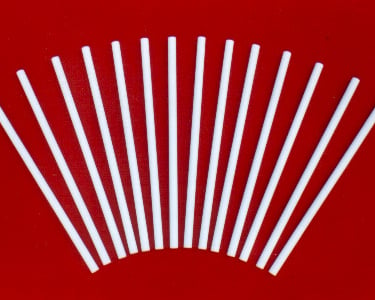Pyrolytic boron nitride ceramic clamping rod
Spiral line traveling wave tubes as the main high-power microwave amplifier parts, are the key components of radar, electronic countermeasures, relay communications, satellite communications, television live satellite, navigation, remote sensing, remote control and telemetry, and other electronic equipment, in the national defense equipment such as millimeter wave radar, satellite, airborne communications and electronic countermeasures and other fields have an important role and broad application prospects.
The clamping rod as a spiral line wave tube in the off-weight parts mainly plays four roles, one is in the shell of the clamping spiral line, the second is to provide a thin film attenuator "carrier", the third is to play a role in thermal conductivity, the heat generated in the tube to the outer surface of the shell promptly, the fourth is the performance of the clamping rod related to the spiral line wave tube high-frequency characteristics, such as standing wave, phase velocity, etc. The high working frequency and small size of the spiral line wave tube put forward extremely high requirements for the clamping rod, mainly in the straightness of the product up to 0.01mm, surface roughness Ra ≤ 0.6μm, high dimensional accuracy to ± 0.005mm and complex shape. Clamping rod material dielectric loss angle tangent value is low, with low dielectric constant, high-temperature thermal conductivity, and other aspects, the commonly used aluminum oxide and beryllium oxide can no longer meet the technical requirements.
Pyrolytic boron nitride code PBN ceramic material is a kind of boron nitride ceramic plate prepared by a vapor deposition method, because of its non-toxic, high-temperature thermal conductivity decay is small (within 300 ° C with almost no decay), low dielectric constant and other characteristics to become one of the preferred materials for ultra-high power traveling wave tube clamping rod. Size, because the plate thickness is more fixed usually only 0.8mm, 1mm, 1.2mm, and 1.5mm a few specifications, and are much larger than the size of the clamping rod products, so the surface processing area of the boron nitride substrate up to 100%. During processing, considering the thermal conductivity of PBN material in the direction of deposition, i.e. thickness and length or width, there is a big difference in heat conduction.
Meanwhile, due to the low bulk density of the boron nitride clamping rod, the elasticity of the material itself, the complexity of repeated positioning during product processing, the randomness of the size, shape, and abrasive distribution of the processed grinding wheel, and the complexity of the grinding motion law, it brings great difficulties to the research of the grinding mechanism of boron nitride clamping rod. However, the current backwardness of high-precision boron nitride ceramic clamping rod precision processing capability cannot meet the high-precision requirements of this product, and the domestic must import high-performance PBN clamping rod through abnormal channels. However, due to changes in the international environment, the PBN clamping rod is in danger of being embargoed at any time, which will greatly impact the development and production of related weaponry and civilian communication electronics.
Therefore, researching high-precision boron nitride clamping rod processing technology, designing a reasonable processing process and control method to ensure the performance of the boron nitride clamping rod substrate and improve the dimensional accuracy of the product has become an urgent technical problem for technicians in this field.
Clamping rod performance
Width tolerance ±0.005mm
Height tolerance ±0.005mm
Symmetry 0.01mm
Surface roughness Ra<0.6μm
Perpendicularity 0.01mm
Straightness 0.01mm


